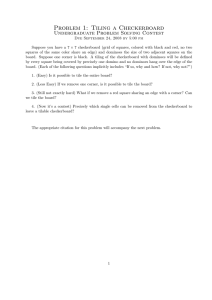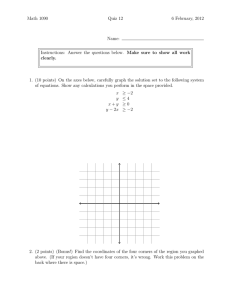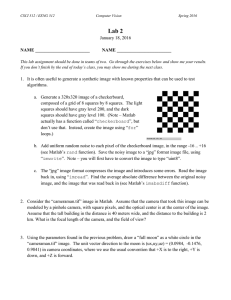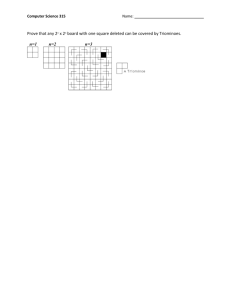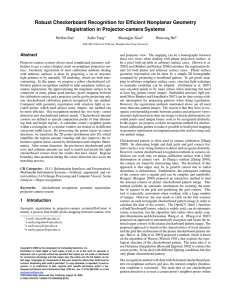Augmented Reality Checkers (English Draughts)
advertisement
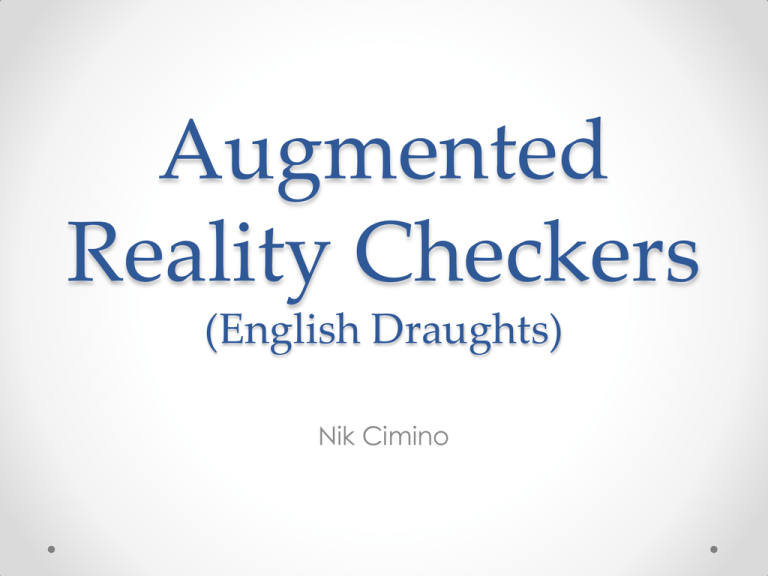
Augmented Reality Checkers (English Draughts) Nik Cimino Introduction • Purpose o New user interfaces are a growing market o Games make money, and are fun! • Goals o Use computer vision to interface the physical world to the digital world o Use OpenCV (C++ Library) to build the aforementioned interface • Assumptions o Checkerboard needs to be close to camera o Surroundings should have limited numbers of edges Research • Color based edge detection – Piece identification o Similar colors differentiation can be optimized using color based edge detection (1) o The checkers game pieces are often similar in to the checkerboard, in color • Checkerboard detection o Hough lines can be grouped with voting (similar to RANSAC) for pose estimation (2) o Pose estimation is essential for deterministic results 1. Koschan, A. A Comparative Study On Color Edge Detection. s.l. : Institute for Technical Informatics, 1995. 2. Zimmerman, F. Schaffalitzky and A. Planar Grouping for Automatic Detection of Vanishing Lines and Points. s.l. : University of Oxford, 2000. Color Edge Detection • Research suggests color based edge detection • In practice, grayscale yielded the optimal result Color Edge Detection (cont.) Blue Grayscale Greed Red Checkerboard Identification • Attempted similar angles approach to find corners • In practice, the outer limits were not the corners • This approach did not work Checkerboard Identification • Attempted similar angles approach to find corners • In practice, the outer limits were not the corners • This approach did not work Checkerboard Identification • Attempted similar angles approach to find corners • In practice, the outer limits were not the corners • This approach did not work Checkerboard Identification (cont.) • Hough Line Transform with a voting scheme worked • Hough lines with corner detection was optimal • Fairly robust solution, works well with outliers Vanishing point voting can fail if lines are parallel Without vanishing point voting, lines may not lie on checkerboard plane Camera Calibration • Camera is calibrated on start-up or file is loaded (3) • Fortunately, there is a checkerboard present 3. OpenCV. Camera calibration With OpenCV. OpenCV Documentation. [Online] 04 05, 2013. [Cited: 04 25, 2013.] http://docs.opencv.org/doc/tutorials/calib3d/camera_calibration/camera_calibration.html. Camera Calibration (cont.) • After calibration the video feed is undistorted Filtering Noise • Using a running average can mitigate noise • Ambient noise can cause false positives • A natural solution to final piece placement Filtering Noise (cont.) • Piece movement example Hough Lines • Edge detection begins with a Canny Edge Detector • After Canny a Hough Line Transform is applied cv::Canny and cv::HoughLines Hough Line Filtering • Vanishing point voting is used to group planar lines • Minima and maxima rho give us interest lines • Interest line intersections yield good tangent points Without vanishing point voting, only rho can be used to filter lines, and this can leave lines that do not lie on the checkerboard plane Initial Corner Detection • Pose determination requires model matching • Corners are detected using Shi and Tomasi cv::goodFeaturesToTrack and cv::cornerSubPix Board Corner Detection • Checkerboard corner detection • Interest line intersection’s closest points are used Affine Transformation • Board corners are matched to a model • An affine transformation is derived and applied cv::getPerspectiveTransform and cv::warpPerspective Final Corner Detection • Homographic image is converted to grayscale • The corners of the planar board are detected The original corners could’ve been transformed! Hough Circle Detection • A Gaussian blur is applied • After the blur a Hough Circle Transform is applied cv::GaussianBlue and cv::HoughCircles Extracting Game Pieces • Match if circles centers are close to square centers • Keep a running average of matches Beginning the Game • If user pieces match a template, then game begins • When game starts add virtual pieces Innovative Correlation • Corners are identified with modulus o Image is 480 pixels by 480 pixels o With 8 squares that is 60 pixels per row and column o A good corner has it’s center at modulo 60 +/- a buffer • Centers are identified with modulus • Hough line angle voting is done based on modulus o Lines are sorted with a custom algorithm o Modulus is used to make 0 = 2 * pi = 4 * pi, and pi = 3 * pi = 5 * pi o Sorted lines now correlate with direction Noise Tolerant Piece Detection • Running average of piece detections (heat map) • Threshold results to remove anomalies • An 2-D array of values from 0 to 1 Future Work • Better corner identification o There may be better ways to match a checkerboard o It is known that the checkerboard squares have alternating color o Template matching? • Better edge voting o There may be better ways to filter the Hough lines, instead of using vanishing point voting combined with min and max rho o Linear regression with line of best fit and compare slopes? • Better piece identification o Examining color channels was inferior to grayscale o Perhaps some combination of the color channels could be used for piece identification Questions?
